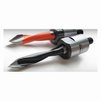 In the production industry it seems there is a lot of just about everything. Certainly, any of us that has bumped into the industry more than a time or two knows there are quite a bit more than a lot of drill bits to choose from. Contrary to some opinion, though, the numerousness of these accessories is not meant to confound us, but rather to compliment our applications and improve our results.
In the production industry it seems there is a lot of just about everything. Certainly, any of us that has bumped into the industry more than a time or two knows there are quite a bit more than a lot of drill bits to choose from. Contrary to some opinion, though, the numerousness of these accessories is not meant to confound us, but rather to compliment our applications and improve our results.
In fact, there is a drill bit specifically designed for just about every hole-type and every working material under the sun – this means that for each project or each application you endeavor, you might feasibly require a different drill bit. From metal and ceramics to glass, plastic, marble, wood, and many et ceteras, there’s a drill bit for that. So, let me provide for you the most basic of drill bit basics.
 A BIT ABOUT BITS:
A BIT ABOUT BITS: 
First, although there are hundreds of different bits and different ways to use them, virtually all drill bits are talked about with the same vocabulary. In other words, they’re mostly made up of the same parts:
The Tip:
Moving from front to back, most all drill bits begin with a tip. This is exactly what it sounds like, a tip, usually with a sharp edge or point that begins the working half of the bit. The tip is, more or less, the spearhead of a drill bit and will often act as a self-centering characteristic.
The Lip:
Next down the line are the lips of the bit which are the usually spiraling cutting edge(s). The bit’s lip angle usually determines the temperament or overall aggressiveness of the drilling action.
The Flute:
The grooves spiraling beneath the lips are the flutes of the bit which act as channels for material ejection. As the bit penetrates deeper into a material excess material is forced out through the flutes as the hole is drilled. The bigger the flute, the faster a bit can expel material and therefore drill.
The Spiral:
The spiral of the bit is made up of its lips and flutes and refers to the rate of twist within the working half of the bit. This, as aforementioned, controls the rate of material removal while drilling, and the quality of the subsequent hole.
The Shank:
Lastly, is the bit shank. This is the piece of the bit that fits into your drill chuck. The shank is probably the most boring (as in uninteresting, not to be confused with actually boring a hole) part of a drill bit. It is, however, no less important to your drilling performance. The shank is mostly smooth and roundish and may also contain design features meant to more snugly keep it in your chuck.
Each pieces of any given drill bit contributes to the general behavior of the bit. In other words, bits designed for precision work will have a different tip and lip angle than bits designed for more aggressive drilling. Similarly, bits designed for ceramics will structurally differ from those designed for wood or metal.
MEASUREMENT:
The above vocabulary gives us another way to discuss and identify our drill bits – measurement. If you’ll remember from geometry, the diameter is the length (through the middle) of one end of a circle to the other. In other words, if you were to cut a hamburger in half, the length of the flat side of your now halfed hamburger would be its diameter.
Shank Diameter and Bit Diameter:
So, the shank diameter is simply the measurement of the end of the shank. Your bit diameter, then, is the measurement of the opposite end of the drill bit – the less boring part, the tip.
Flute Length and Overall Length:
The flute length is the length of the working half of the bit which excludes the shank. The overall length, then, refers to the length of the entire piece – shank and flute included.
Rate of Spiral:
The rate of spiral refers to width of the lips and flutes, or, the amount of vertical space the flute takes up between each lip and the lip takes up between each flute. This may also include the depth of a bit’s lips and flutes.
Of course, there are many more types of measurement that are specific to the design of more complicated bits – but, for the sake of basics, this provides a general groundwork that can be built upon as your experience grows.
COMMON TYPES OF DRILL BIT:
Now that we know a bit about how to talk about bits, let me provide some info about the most commonly used types of drill bit.
 Twist or Morse Bit:
Twist or Morse Bit:
A twist or Morse bit is probably the most common type of drill bit. Accordingly, it is very likely the image that materializes in your brain when you think of a drill bit. Although best suited for metal drilling applications, the design of a twist bit allows it to be used in virtually every different industrial materials. The drilling speed generated by this type of bit, however, renders it less appropriate for precision or delicate applications.
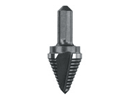 Step Drill Bits and Unibits:
Step Drill Bits and Unibits:
Though not always practical, due to their overall awesomeness, step drill bits and unibits are perhaps my personal favorite type. Like twist bits, they can be used in any number of industrial materials, and due to their unique shape, usually conical in nature, these bits are designed with the capacity to, at once, drill multiple hole sizes. The bit diameter of these bit types increases from the tip in specific increments following a stair-step profile – like a pyramid, each tier of the bit drills a hole with a different, larger diameter.
 Split Point Bit:
Split Point Bit:
A split point bit varies only slightly from its twist bit brothers. Designed most specifically for metal cutting, the points and angles of this bit are sharper and more narrow. The literally “split” split point design of the bit is intended to prevent it from losing center despite intense drilling torque or difficult materials.
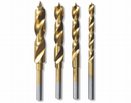
 Brad Point Bit:
Brad Point Bit:
The brad point bit or, also known as a doweling bit or lip and spur bit, is primarily a woodworking accessory. These bits are generally designed with a sharp central point at their tip with brads or spurs protruding around the outside of the bit’s cutting edges. This design is meant to self-center and maintain center while drilling. The unique profile of the bit additionally allows it to drill holes from the outside in leaving a far smoother, cleaner hole with decidedly more smoothness at the bits exit point. For this reason, the brad point bit is usually a favorite for sensitive projects and applications.
 Countersink Bit:
Countersink Bit:
As the name would imply, these specialty bits are designed for producing a countersink hole into a working material. A countersink hole is a preliminary indent, if you will, which allows the head of a screw to sit flush with, if not beneath, the level of your working material. A countersink bit is began with a twist bit tip designed to start the screw-hole, the tip is then followed by a cylinder with a generally conical shape atop it, similar to a more robust arrowhead, that carves out a pocket for the screw-head.
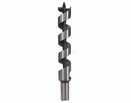
 Auger Bits:
Auger Bits:
An auger bit is a self feeding bit used to bore long holes into wood. They are designed with a small point on their tip which accounts for its self-feeding capacity and contributes to fast drilling and more accurate centering. The flutes in an auger bit are especially deep and wide for faster material clearing. This design, however, also renders the holes quite rough around the edges. Because they are frequently used for drilling through framing studs, it is not uncommon for auger bits to be very long.
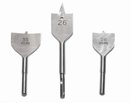 Spade Bits:
Spade Bits:
You might also know this little sucker as a paddle bit. Whatever you call it though, this bit, similar to an auger bit, has a pointed tip and is used to bore fast, rough cuts into wood. Unlike an auger bit, though, a spade bit is shaped, well, like a spade (or paddle), with cutting edges on its sides to aggressively bore into wood.
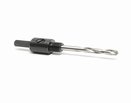
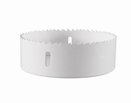 Hole Saw Bits:
Hole Saw Bits:
A hole saw bit acts quite a bit like the name implies, a saw. Coming together in two parts, a hole saw bit is made up of a mandrel (first pic on the left), which fits into your drill chuck and a twist bit which fits into the mandrel and sits in the center of the bit’s second part – the hole saw or bit ring (second pic on the left). This is a perfectly circular attachment with serrated saw teeth designed to cut very smooth holes from your working material. Cutting only the edges of the hole, the hole saw bit cuts very smooth holes and uses its energy efficiently making it appropriate for use with a hand-drill.
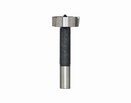
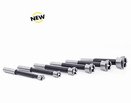 Forstner Bits:
Forstner Bits:
Forstner bits are perhaps the most aggressive of the woodworking bits. They look, to me, quite a bit like and open bear trap with a central point surrounded by a generally cylindrical formation of saw teeth or boring shears with planing blades running through its diameter. Using the force of these planing blades and their cylindrical shear design, the bit bores precise flat-bottom holes. Unlike hole saw bits, because these accessories require a significant amount of force and energy to penetrate and bore into a material, they are usually used in machines (drill presses and lathes) rather than standard hand-drills. Additionally, forstner bits don’t have any flutes or other mechanism to remove material during drilling, consequently, the bit must be periodically removed to clear debris from the hole.
WHAT YOUR BITS ARE MADE OF:
In addition the the clearly numerous types and styles of drill bit, there are just as many materials that any given bit can be forged of. Depending on the material your drill bit is made of, it will, obviously, be better or worse with any given application or material. Different bit fabrication materials contribute to everything from overall bit longevity, to sharpness, resistance, and strength. As it turns out, as your bit material gets harder, the bit itself not only becomes more expensive, but more brittle as well. Likewise, the softer the bit material, the sooner you will loose the sharp edge of your bit. Knowing the right drill bit material for each drilling material is a vital part of ensuring the best results and a more efficient and economic project. Just because a bit can perform a specific application, doesn’t mean it should.
Beginning with softer, simpler bits and advancing to stronger and more complex materials and designs, there are several steel types, steel alloys, carbides and other coatings that typically make-up a drill bit.
Low carbon steel:
Low carbon steel bits are soft and designed for working specifically with wood and soft plastics. They don’t retain their cutting edges well and require frequent sharpening, as such, they are generally inexpensive and provide an accessory that is practical and economical for many crafters.
High Carbon Steel:
Although these a still a generally soft bit, high carbon steel bits are harder and more durable than their low carbon counterparts. They can be used in either wood or metal but do lose temper and their sharp cutting edges if overheated.
High Speed Steel:
Next on the totem pole is high speed steel, or HSS. Because they’ve been additionally hardened and tempered, these bits are much more resistant to high temperatures and perform well in wood, metal, and most ceramic materials. As the name suggests, these bits perform at very high speeds. They have, more or less, eliminated the demand for carbon steel bits among professional production workers.
Cobalt Steel Alloy:
Like HSS bits, cobalt steel alloy bits perform well in high temperatures and in a variety of materials. Although cobalt bits maintain temper in higher temperatures, and are hard enough to work in stainless steel and other like materials, their higher concentration of cobalt renders the bits more brittle as well. Despite this, these bits generally offer higher performance and greater longevity.
Titanium and Other Coatings:
Ceramic titanium coatings are used to cover or coat a softer bit and render the resulting bit significantly stronger, longer lasting, and sharper than other, non-tipped or non-coated bits. Coated bits, however, can not be sharpened without losing the strength and general effectiveness of their coating. Black oxide, titanium nitride, titanium aluminum nitride, and titanium carbon nitride are among other ceramic coatings that can dramatically enhance the quality and performance of a drill bit.
Tungsten Carbide (Tipped):
Carbide bits are extraordinarily hard and strong, in fact, they are among the most durable and high-performance bits in the present industry. They can drill into virtually any material and they will maintain their sharp edges for significantly longer than bits made of or coated with other materials. Consequently, these bits are quite expensive, so, although some industries use entirely carbide bits, due to their cost and their general brittleness, softer bits are often coated or “tipped” with carbide materials. The “tipped” quality of these bits renders them, essentially, unbeatable for most applications.
In summary, knowing what projects you have before you is probably the most effective way to determine which bits and of which materials you’ll need to have on hand. Harder materials require harder, sharper, and usually self-centering bits whereas softer materials require a less intense bit and bit material. Additionally, the strongest bits are usually the most brittle and definitely the most expensive – and – although perhaps more boring, sometimes even the least flashy or fancy drill bit is the most appropriate for the job.













